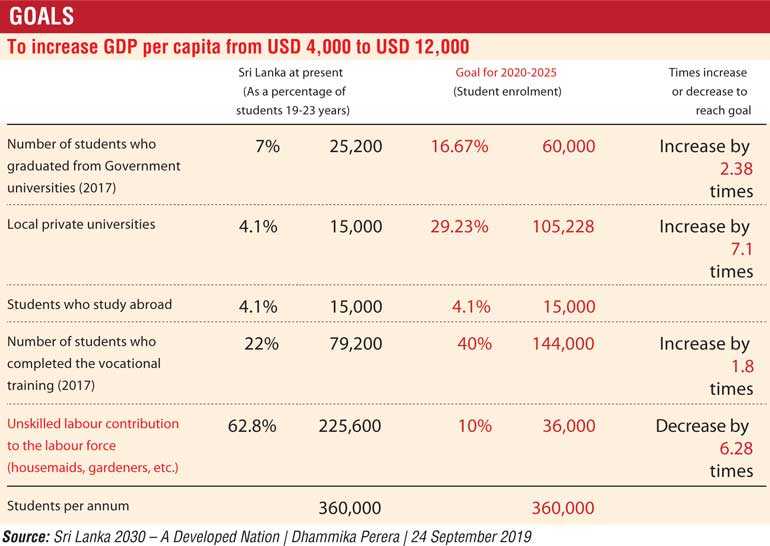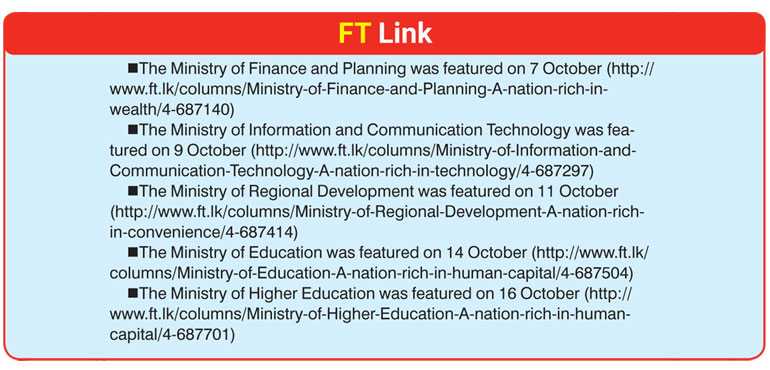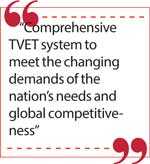Monday Dec 08, 2025
Monday Dec 08, 2025
Friday, 18 October 2019 00:30 - - {{hitsCtrl.values.hits}}

This series is based on business leader
Dhammika Perera’s recently revealed
‘Economic Growth Strategy and Action Plan to increase GDP Per Capita from 
$ 4,000 to $ 12,000’. The document outlines goals and action plans for 23 ministries and today’s column focuses on the Ministry of
Technical,
Vocational Education and Training (TVET)
GOALS
revise training standards, skills
training and the certification system.

ACTION PLAN
1. Rebrand TVET to be an attractive learning choice by producing a dedicated brand guideline.
2. Enhance the quality of programmes to improve graduate and foreign employability, by enabling industry professionals to lead curriculum development.
3. Implement 0% Corporate tax and 0% VAT on TVET education. Corporate tax and VAT rates to be guaranteed for the next 25 years to aid building private TVET universities.
4. Introduce new TVET courses after evaluating those available in India, Germany and Malaysia to match job market demand.
5. Build a fully equipped TVET Centre in each district, with qualified lecturers for all NVQ certification levels, to increase TVET certificate holders from 79,200 to 144,000 which will result in 40% of the total 360,000 students per annum.
6. Upgrade existing technical education centres in collaboration with world-class institutions.
7. Introduce short courses in the TVET curriculum based on 4 hours, 6 hours, 12 hours, 20 hours, one day, one week and one month.
8. Introduce additional TVET courses in logistics stream catering to the job market demand.
9. Increase the number of TVET courses available for women.
a. Courses in office management, computer operator, programming assistant, tour and travel assistant, etc.
b. In addition, introduce short courses (1 to 2 weeks) in hair care, facials, nail art and sewing garments.
10. Introduce ‘Train the Trainer’ courses for TVET instructors to enhance their skills.
11. Ensure availability of free online language courses to all citizens.
12. Implement an online skill assessment portal for individuals to assess their current skill levels and to identify areas for improvement.
13. Implement a job bank where unemployed citizens are geo-tagged and directed to jobs matching their skills. This would also monitor new students until they have been employed.
14. Initiate a dedicated plan on district-wise job creation.
a. Tourism related jobs. Training courses for tour guides, retail, homestay operations, beach club operations, bartenders, waiters and receptionists, etc.
b. Hotel sector job creation through online hospitality courses.
c. Training videos for homestay hotel operators.
d. Nursing training courses.
e. Provide funds to conduct courses on handloom, traditional crafts and handicrafts, etc.
15. Launch a dedicated website for TVET students with information on:
a. Technical colleges available in the area.
b. Courses available based on location.
c. Career guidance.
d. Job availability in the area.
e. Video-based TVET course learning.
f. Video-based personal and soft-skill development with grooming tips.
16. Increase intake of students in nursing colleges.